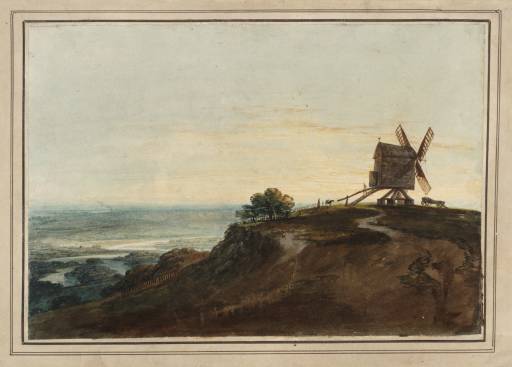Joseph Mallord William Turner A Windmill on a Hill above an Extensive Landscape with Winding River 1794-5
Joseph Mallord William Turner,
A Windmill on a Hill above an Extensive Landscape with Winding River
1794-5
Joseph Mallord William Turner 1775–1851
A Windmill on a Hill above an Extensive Landscape with Winding River 1794–5
D00670
Turner Bequest XXVII I
Turner Bequest XXVII I
Pencil, watercolour and gouache on white wove paper, 193 x 280 mm laid on washed and ruled mount of white wove paper, 210 x 300 mm
Blind-stamped with Turner Bequest monogram towards bottom right
Stamped in black ‘XXVII I’ bottom right
Blind-stamped with Turner Bequest monogram towards bottom right
Stamped in black ‘XXVII I’ bottom right
Accepted by the nation as part of the Turner Bequest 1856
Exhibition history
1983
J.M.W. Turner: Dibujos y acuarelas del Museo Británico, exhibition catalogue, Museo del Prado, Madrid, February–March 1983 (2, reproduced in colour).
2007
Hockney on Turner Watercolours, Tate Britain, London, June 2007–February 2008 (no number).
References
1909
A.J. Finberg, A Complete Inventory of the Drawings of the Turner Bequest, London 1909, vol.I, p.54, XXVII I, as ‘Windmill on Hill ... Windmill on crest of hill, with valley and winding river in middle distance; sunset effect. Mounted, with border worked by Turner’. c.1795.
Technique and condition
The white wove paper was first completely soaked by the application of broad horizontal washes to establish the sky and middle distance in blue, and probably the ground on which the windmill would stand, in brown. The same process can be detected beneath many of Turner’s oil paintings which depict both seascapes and landscape: canvases abandoned early have a similarly luminous appearance to the sky here, since Turner virtually always used a white-primed canvas for oil painting, which gives the same optical effect as the smooth white paper selected for this watercolour.
The peach-coloured clouds were created in a similar way to the first washes, using sweeping horizontal strokes of paint applied to wet paper, but applied with a much finer brush. Denser and often broader washes of brown in the foreground were applied to paper kept damp for the purpose, to build up form and depth for the slope in the foreground, and to create the trees seen against the sky. The windmill itself was painted over the sky, onto dry paper. The brighter mixed green washes were added next, probably by lifting off some of the brown paint locally with a wet brush, to leave a whiter background that would confer more luminosity in these areas. The fence running down to the foreground was also created by first removing rather than adding paint, then painting in the posts with fine brushstrokes on damp paper, so that its brown upright posts are not lost within the brown landscape. Finer details such as the vanes of the windmill, and the wooden fence atop the slope and running down to the valley, were painted in with a fine brush, after the paper had been allowed to dry again.
Two or possibly three shades of brown, one or more of them an ochre, indigo (probably) and Indian yellow were sufficient to create the image, by layering and mixing.
The washes and outlining used to create the washline border include carbon black ink and a wash or brown ochre, but there is very little or no black pigment in the image itself. A washline border round the work is a conventional means of presenting a finished watercolour, though it is more usual to apply the wash to a separate window mount that can be placed on top of the watercolour.
Helen Evans
October 2008
Revised by Joyce Townsend
February 2011
How to cite
Helen Evans, 'Technique and Condition', October 2008, revised by Joyce Townsend, February 2011, in Andrew Wilton, ‘A Windmill on a Hill above an Extensive Landscape with Winding River 1794–5 by Joseph Mallord William Turner’, catalogue entry, April 2012, in David Blayney Brown (ed.), J.M.W. Turner: Sketchbooks, Drawings and Watercolours, Tate Research Publication, December 2012, https://wwwPerhaps an imaginary subject, this appears, as J.P. Heseltine pointed out,1 to be a very early instance of Turner’s use of gouache, which is used in the paling fence that runs down the hill to the left. Compare the technique of Tate D00691 (Turner Bequest XXVIII F), which paraphrases J.R. Cozens (1752–1797). This composition would appear to imitate Rembrandt (1606–1669), inspired perhaps by some etchings and drawings, or even possibly the famous painting of The Mill, now in the National Gallery of Art, Washington. Turner was to imitate this latter more explicitly in his painting Windmill and Lock of 1810 (currently untraced).2
Verso:
The back of the mount blank.
Andrew Wilton
April 2012
How to cite
Andrew Wilton, ‘A Windmill on a Hill above an Extensive Landscape with Winding River 1794–5 by Joseph Mallord William Turner’, catalogue entry, April 2012, in David Blayney Brown (ed.), J.M.W. Turner: Sketchbooks, Drawings and Watercolours, Tate Research Publication, December 2012, https://www

